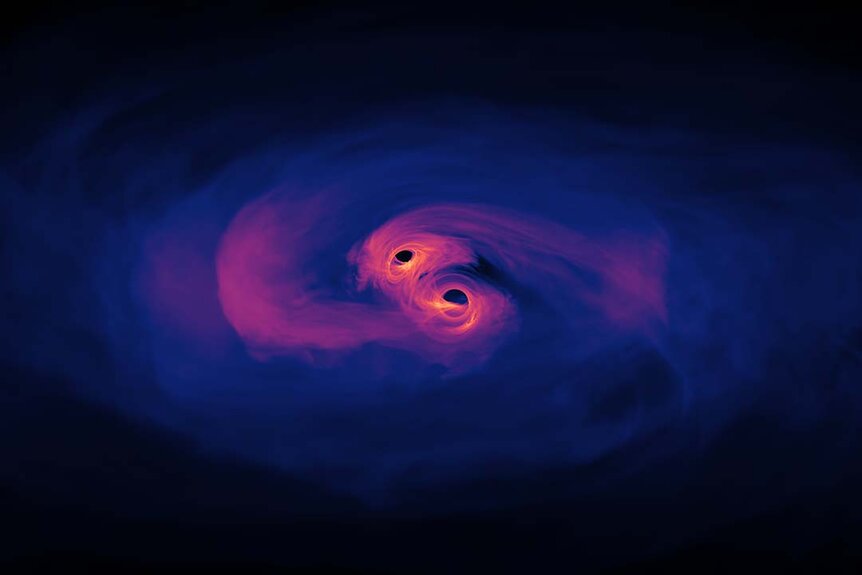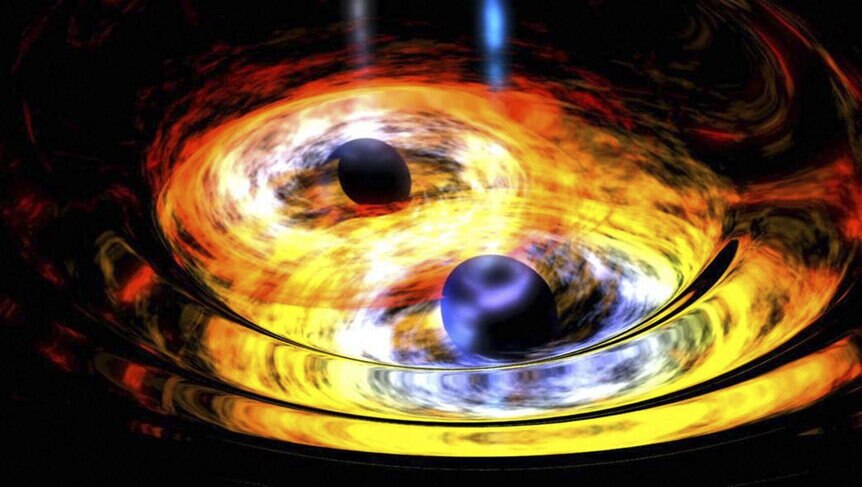Create a free profile to get unlimited access to exclusive videos, sweepstakes, and more!
Heaviest Black Hole Pair Ever Found Weighs in at 28 Billion Times the Mass of the Sun
They're stuck 24 light-years apart.
When John Crichton (Ben Browder) accidentally zoomed across the galaxy in Farscape (streaming now on Peacock), he found himself swept up in an interplanetary war with the fate of the universe on the line. As the galactic conflict escalated, a black hole weapon was created with the power to destroy the universe. Once initiated, a newly formed black hole would double in size every few seconds until it swallowed all of existence. Fortunately, Crichton and co. were able to stop things from crossing the point of no return.
In the real world, something similar is happening (minus the cosmic combat) with a pair of black holes 750 million light-years from here. Nestled inside the elliptical galaxy BR 0402 + 379, astronomers have discovered a bound pair of black holes frozen a few short light-years away from one another.
Biggest Black Hole Binary, 28 Billion Times the Mass of the Sun, Caught in a Distant Dance
Almost all large galaxies have supermassive black holes at their centers around which the rest of the galaxy orbits. Meanwhile, those galaxies are moving through space and sometimes one or more of them smash together, merging into an even more massive galaxy. When that happens, their black holes have to come to a new arrangement.
Often, those black holes merge, but sometimes they get caught in a perpetual dance, circling around one another for millions of years. The recently discovered pair of black holes were once spiraling toward one another but seem to have gotten stuck, according to a recent study published in The Astrophysical Journal.
For More on Black Holes:
Biggest and Hungriest Black Hole Ever Discovered Eats a Sun a Day
JWST Spies Oldest Black Hole Ever Found at the Fringes of the Known Universe
Parasitic Black Holes Could Be Eating Some Stars (Including the Sun) from the Inside
After the initial detection using the Gemini North telescope in Hawaii, astronomers combed through archival data from the Gemini Multi-Object Spectrograph (GMOS) to clock the speed of nearby stars and figure out the mass of the black holes. Once the scales were balanced, the total came in at a staggering 28 billion times the mass of the Sun.
“The excellent sensitivity of GMOS allowed us to map the stars’ increasing velocities as one looks closer to the galaxy’s center. With that, we were able to infer the total mass of the black holes residing there,” said study co-author Roger Romani, in a statement.
Astronomers believe that the binary formed not from the collision of two galaxies, but from a massive intergalactic pileup. Multiple smaller galaxies each with their own black hole came together to create these two cosmic colossi. They combined until only these two big boys were left over, and then things stalled out.
As two supermassive black holes get close to one another, they don’t zoom together like magnets. Instead, they spin around one another like two figure skaters latching hands as they pass in opposite directions. As they play supermassive Ring around the Rosie, they ditch energy into gas, dust, and stars, slowing down and getting closer together. In the process, they push the stars, gas, and dust away, clearing the space around them.
It’s the cosmic equivalent of a couple of runaway 18-wheelers going up a gravel incline to slow down. In this case, the binary seems to have run out of runway before running out of steam. Without any more nearby stars to transfer energy to, the orbital decay stalled, and they got locked in a stasis roughly 3 billion years long.
“Normally it seems that galaxies with lighter black hole pairs have enough stars and mass to drive the two together quickly. Since this pair is so heavy it required lots of stars and gas to get the job done. But the binary has scoured the central galaxy of such matter, leaving it stalled and accessible for our study,” Romani said.
In order for the binary to finally take the plunge, they might need a fresh delivery of matter to push around. If another galaxy got into the mix and pushed the system over the edge, if these two black holes did finally merge, they would create gravitational waves a hundred million times more powerful than any we’ve seen before. For now, they’re content to dance.
Catch the complete run of Farscape streaming now on Peacock.
































